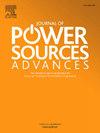Numerical simulations of all-solid-state batteries using specific contact area diameters for active materials determined by X-ray computed tomography
Abstract
At present, it would be desirable to improve the C-rate values of bulk-type all-solid-state lithium-ion batteries by optimizing the electrode structures. Although simulations are an effective means of determining optimal structures, a high degree of accuracy is required. The present study demonstrates a pseudo-two-dimensional (P2D) method of simulating cathodes providing improved accuracy along with low computational cost and based on actual three-dimensional electrode structures. This method incorporates the volume fraction and tortuosity of the solid electrolyte (SE) and active material (AM), both of which are widely used in conventional simulations, and takes into account the specific contact area diameter (DSCA) of the AM. The latter parameter reflects the extent of AM particle aggregation and is obtained from the analysis of three-dimensional X-ray computed tomography images. The validity of these P2D simulations is confirmed by comparison with experimental results for three electrodes having different SE particle sizes. The experimental result shows that battery capacity is increased with decreases in the SE particle sizes. This effect is not predicted using conventional P2D simulations employing only volume fraction and tortuosity but is reproduced by P2D simulations in which DSCA values are used to model AM particle aggregation and Li diffusion within AM particles.

 求助内容:
求助内容: 应助结果提醒方式:
应助结果提醒方式:


